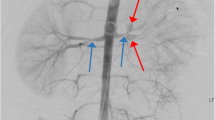Abstract
Background
Fibromuscular dysplasia (FMD) and neurofibromatosis type 1 (NF1) are the most common causes of pediatric renal artery stenosis (RAS) in western countries, and characterization of their angiographic features could aid in an accurate diagnosis and in treatment.
Objective
This study characterizes renal angiographic findings in pediatric fibromuscular dysplasia (FMD) and neurofibromatosis type 1(NF1).
Materials and methods
We reviewed 68 angiograms performed over 11 years on 43 children with renovascular hypertension (20 male, 23 females; ages 1 month to -19 years; median/average 9.8 years). Ten patients were diagnosed with NF1, and 33 had presumed FMD. The frequency, extent and distribution of lesions were determined and analyzed.
Results
Stenosis was found in 91% of patients (n = 39/43), with 86% showing stenosis of 1st or 2nd order arteries, and 12% distal to 2nd order. Stenoses in multiple 1st/2nd order arteries were found in 32% of patients, and 36/43 patients had 1-2 stenoses. The most common lesion was a ≤5 mm stenosis in a 1st/2nd order artery, in 42%. Mean percentage of stenosis in a 1st/2nd order vessel was 62%; ≥70% stenosis was found in 53%, and ≥90% stenosis in 29%. Bilateral disease was noted in 30% of patients. Intraparenchymal disease, distal to 2nd order branches, was seen in 30%. Aneurysms were seen in 28%, beading in 19% and collaterals in 51% (associated with ≥70% stenosis). Mid-aortic narrowing was seen in 16%, more often in patients with NF1.
Conclusion
We provide a descriptive characterization of renal angiographic findings in pediatric FMD and NF1.










Similar content being viewed by others
References
Dillon MJ (1997) The diagnosis of renovascular disease. Pediatr Nephrol 11:366–372
Shroff R, Roebuck DJ, Gordon I et al (2006) Angioplasty for renovascular hypertension in children: 20-year experience. Pediatrics 118:268–275
Courtel JV, Soto B, Niaudet P et al (1998) Percutaneous transluminal angioplasty of renal artery stenosis in children. Pediatr Radiol 28:59–63
Tullus K, Brennan E, Hamilton G et al (2008) Renovascular hypertension in children. Lancet 371:1453–1463
Baxi R, Epstein HY, Abitbol C (1981) Percutaneous transluminal renal artery angioplasty in hypertension associated with neurofibromatosis. Radiology 139:583–584
Stanley P, Hieshima G, Mehringer M (1984) Percutaneous transluminal angioplasty for pediatric renovascular hypertension. Radiology 153:101–104
Vo NJ, Hammelman BD, Racadio JM et al (2006) Anatomic distribution of renal artery stenosis in children: implications for imaging. Pediatr Radiol 36:1032–1036
Bayazit AK, Yalcinkaya F, Cakar N et al (2007) Reno-vascular hypertension in childhood: a nationwide survey. Pediatr Nephrol 22:1327–1333
Slovut DP, Olin JW (2004) Fibromuscular dysplasia. N Engl J Med 350:1862–1871
Deal JE, Snell MF, Barratt TM et al (1992) Renovascular disease in childhood. J Pediatr 12:378–384
Tyagi S, Kaul UA, Satsangi DK et al (1997) Percutaneous transluminal angioplasty for renovascular hypertension in children: initial and long-term results. Pediatrics 99:44–49
Begelman SM, Olin JW (2000) Fibromuscular dysplasia. Curr Opin Rheumatol 12:41–47
Casalini E, Sfondrini MS, Fossali E (1995) Two-year clinical follow-up of children and adolescents after percutaneous transluminal angioplasty for renovascular hypertension. Invest Radiol 30:40–43
Lemahieu SF, Marchau MMB (1979) Intracranial fibromuscular dysplasia and stroke in children. Neuroradiology 18:99–102
Makker SP, Moorthy B (1979) Fibromuscular dysplasia of renal arteries: an important cause of renovascular hypertension in children. J Pediatr 95:940–945
Khan AN (2008) Neurofibromatosis type 1. Available via http://emedicine.medscape.com/article/342500-overview. Accessed 26 July 2010
Fossali E, Signorini E, Intermite RC et al (2000) Renovascular disease and hypertension in children with neurofibromatosis. Pediatr Nephrol 14:806–810
Hamilton SJ, Friedman JA (2000) Insights into the pathogenesis of neurofibromatosis 1 vasculopathy. Clin Genet 58:341–344
McLaren CA, Roebuck DJ (2003) Interventional radiology for renovascular hypertension in children. Tech Vasc Interv Radiol 6:150–157
O’Neill JA, Berkowitz H, Fellows KJ et al (1995) Midaortic syndrome and hypertension in childhood. J Pediatr Surg 30:167–172
Tegtmeyer CJ, Elson J, Glass TA et al (1982) Percutaneous transluminal angioplasty: the treatment of choice for renovascular hypertension due to fibromuscular dysplasia. Radiology 143:631–637
Sos TA, Pickering TG, Sniderman K et al (1983) Percutaneous transluminal renal angioplasty in renovascular hypertension due to atheroma or fibromuscular dysplasia. N Engl J Med 309:274–279
Cluzel P, Raynaud A, Beyssen B et al (1994) Stenoses of renal branch arteries in fibromuscular dysplasia: results of percutaneous transluminal angioplasty. Radiology 193:227–232
Chevalier RL, Tegtmeyer CJ, Gomez RA (1987) Percutaneous transluminal angioplasty for renovascular hypertension in children. Pediatr Nephrol 1:89–98
Towbin RB, Pelchovitz DJ, Cahill AM et al (2007) Cutting balloon angioplasty in children with resistant renal artery stenosis. J Vasc Interv Radiol 18:663–669, Erratum in: J Vasc Interv Radiol
Tanaka R, Higashi M, Naito H (2007) Angioplasty for non-arteriosclerotic renal artery stenosis: the efficacy of cutting balloon angioplasty versus conventional angioplasty. Cardiovasc Intervent Radiol 30:601–606
Tanemoto M, Abe T, Chaki T et al (2005) Cutting balloon angioplasty of resistant renal artery stenosis caused by fibromuscular dysplasia. J Vasc Surg 41:898–901
Alhadad A, Mattiasson I, Ivancev K et al (2005) Revascularisation of renal artery stenosis caused by fibromuscular dysplasia: effects on blood pressure during 7-year follow-up are influenced by duration of hypertension and branch artery stenosis. J Hum Hypertens 19:761–767
Acknowledgement
Some of this material was presented at the 2009 Society for Pediatric Radiology Annual Meeting.
Author information
Authors and Affiliations
Corresponding author
Rights and permissions
About this article
Cite this article
Srinivasan, A., Krishnamurthy, G., Fontalvo-Herazo, L. et al. Spectrum of renal findings in pediatric fibromuscular dysplasia and neurofibromatosis type 1. Pediatr Radiol 41, 308–316 (2011). https://doi.org/10.1007/s00247-010-1854-9
Received:
Revised:
Accepted:
Published:
Issue Date:
DOI: https://doi.org/10.1007/s00247-010-1854-9




